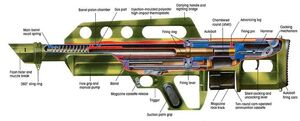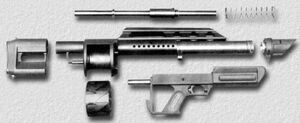The Pancor Jackhammer was a prototype fully automatic, 12 gauge revolving bullpup shotgun designed by John Andersen in 1984 and produced by Pancor Corporation in very limited quantities.
History
The Pancor Jackhammer was designed by John Anderson in 1984 and patented in 1987. Anderson was a Korean War veteran familiar with pump action combat shotguns, but wanted more efficient ways to fire the weapon, prompting him to create an automatic shotgun design, the Jackhammer.
After making dozens of mockups, Anderson built a working proof-of-concept prototype. Anderson then made two more auto-capable prototypes with an improved reloading mechanism, and submitted them to the US military for full destructive testing. Testing found the weapon to be overly heavy and uncomfortable to shoot, and it was noted the cylinder grooves had to be manufactured to extremely tight tolerances and the weapon frequently failed to cycle in automatic mode. The weapon was ultimately rejected.
The original proof-of-concept prototype was kept by Anderson and later sold to Movie Gun Services, who rented it to comic book, video game, and movie companies. This is now the sole surviving functional prototype Jackhammer in the world. The weapon was later auctioned off at Morphy Auctions.[1][2] Notably, Movie Gun Services modified the surviving prototype as they found the original forend was too slippery to achieve a firm grip (needed for properly operating the weapon), and so added the handguard of a Heckler & Koch MP5SD.[1]
During the development of the Jackhammer, Anderson made improvements on the weapon's design, creating the MK3 model which featured altered furniture designs. The MK3 was not fully developed before the project was abandoned, and only mockups of the MK3 model were made. One of the mockups of the Pancor Jackhammer MK3, with the serial number "JH MK3-A2", had been in the possession of John Anderson's widow, and has been placed on auction at Morphy Auctions.[3][4][5]
Design Details

Cut-away diagram of the Jackhammer's internals.
The Jackhammer has a selector switch on its side, and can be set to safe, semi-auto, and full-auto at a cyclic rate of 240 rounds per minute. The Jackhammer is cocked by pumping the forend back-to-forward, in a similar manner to the Neostead shotgun. A hooked handle resembling a trigger is located in the hollow of the stock: this "silent cocking lever" could potentially be used for the described function, but was largely present as a restrike lever to cock the action without rotating the cylinder.
The cylinder of the Jackhammer (also called a "cassette magazine," though lacking a follower it was not a magazine) has grooves on it, which allows it to rotate when firing in a manner similar to the Webley-Fosbery automatic revolver. The mechanism is indexed by a cam on an operating rod attached to the barrel, which moves in a zig-zag groove to rotate the cylinder to the next chamber with each forward-back motion. The barrel is blown forward by gas tapped from the bore and returned under spring pressure. As it returns, it forms a gas seal in a similar manner to a Nagant Revolver, though the barrel moves backward rather than the cylinder moving forward.
The toolroom prototype that survives is very different to the pre-production models: it is about four pounds heavier, mostly held together with Allen key screws, chambered for standard 12 gauge shotgun shells, is pump-action only, and needs to be almost completely dismantled in order to reload it.

Mk3 mockup disassembled. Note the non-functional grooves on the cassette cylinder.
On the improved models, the Jackhammer could be reloaded by pushing the foreend forwards and then pressing the cylinder release, allowing one to load a new one. The cylinders were intended to be disposable, being preloaded and sealed in the factory and not intended to be reloaded in the field.
One unique feature was that the ammunition cassette could be combined with an additional assembly containing an array of strikers and a pressure plate to turn it into an ersatz landmine, referred to as the "bear trap". The precise utility of this is debatable since the plate was almost as large as another cassette and the "mine" would expend ten rounds to kill one person, even if it was guaranteed someone would actually stand on it. No working Beartrap striker sets were made, only plastic mockups to demonstrate the concept.
Gallery
References
- ↑ 1.0 1.1 Pancor Jackhammer – Forgotten Weapons
- ↑ Lot Detail - (N) THE ONLY REMAINING PANCOR MK3 “JACKHAMMER” SELECT FIRE REVOLVING SHOTGUN MACHINE GUN IN EXISTENCE (FULLY TRANSFERABLE).
- ↑ Pancor Jackhammer Mk3 – Forgotten Weapons
- ↑ Lot Detail - (N) PANCOR JACKHAMMER FULL-AUTO REGISTERED MACHINE GUN SHOTGUN MK3-A2 PRE-PRODUCTION PROTOYPE (FULLY TRANSFERABLE MACHINE GUN AND DESTRUCTIVE DEVICE).
- ↑ https://www.reddit.com/r/ForgottenWeapons/comments/k7l738/pancor_jackhammer_mk3a2_more_info_in_comments/
External Links
- Modern Firearms - Pancor Jackhammer
- Forgottenweapons - Pancor Jackhammer Photos
- http://www.moviegunservices.com/mgs_pancor.htm
- http://www.guns.com/2015/09/08/the-pancor-jackhammer-the-greatest-automatic-shotgun-that-could-have-been/
| ||||||||||||||||||||||||||

